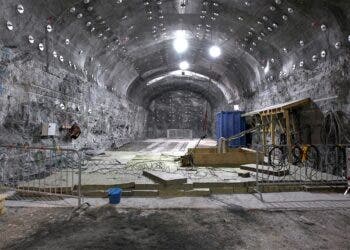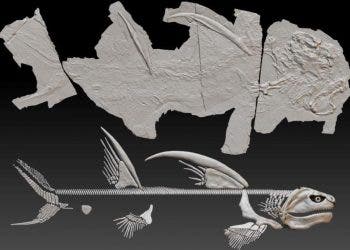
A new study has revealed alarming levels of plutonium contamination near Los Alamos, New Mexico, the site where the first atomic bomb was developed. Radioactive contamination at Los Alamos may sound unsurprising but cleanup efforts by the U.S. government during the 1960s supposedly reduced it to safe levels. Today, the region welcomes many hikers and outdoor enthusiasts who embark on its trails.
The findings have led researchers and watchdog groups to call for immediate federal action. However, the government maintains that the area is safe for recreational use.
The contamination is concentrated in Acid Canyon, a site that once served as a dumping ground for nuclear waste from the Los Alamos National Laboratory. Michael Ketterer, a Northern Arizona University scientist and lead researcher on the project, described the situation as unprecedented in his decades-long career.
“What I found here in Acid Canyon is pretty much the most extreme plutonium contamination scenario . . . in an off-site, uncontrolled environmental setting that I’ve ever seen in my career,” Ketterer told the New Mexico Political Report, adding that the contamination levels are comparable to those found near the Chernobyl Nuclear Power Plant in Ukraine.
A Hidden Legacy of Contamination

Acid Canyon’s contamination stems from its history as a disposal site for radioactive waste from 1943 until 1963. The Los Alamos National Laboratory, under the direction of the Department of Defense, piped liquid nuclear waste into the canyon. Over the years, the site has been the focus of cleanup efforts. But Ketterer’s recent findings suggest that those efforts may not have been sufficient at all.
The study, conducted in coordination with the advocacy group Nuclear Watch New Mexico, found extreme concentrations of plutonium in soil, water, and plant samples. Ketterer expressed shock at discovering such high levels in an area freely used by hikers, bikers, and other outdoor enthusiasts. “This contamination is hiding in plain sight,” he said.
Despite the high concentrations, Ketterer noted that the immediate risk to people traversing the area is low. However, he emphasized the potential long-term environmental threats. Plutonium can migrate downstream, enter water supplies, and be absorbed by plants, eventually making its way into the food chain. Wildfires, which are increasingly common in the region, could also spread the radioactive material through ash.
The work followed mapping done by the group earlier this year that was based on a Los Alamos National Laboratory database including plutonium samples from the area.
Calls for More Thorough Cleanup and Public Awareness

Local public health advocates are demanding more from the government. Jay Coghlan, director of Nuclear Watch New Mexico, has voiced concerns over the legacy of contamination. “The cleanup at Los Alamos is long delayed,” Coghlan said. He further noted that the federal government has prioritized the production of new plutonium pits for nuclear weapons over addressing the environmental fallout from past nuclear activities.
Coghlan, Ketterer, and other experts argue that the federal government should post signs in Acid Canyon warning visitors of the contamination. So far, their calls for action have been met with resistance. The Department of Energy (DOE) claims that the area is safe, pointing to past cleanup efforts and citing radiation levels that are “very low and well within the safe exposure range,” adding that “the information presented by Ketterer and Nuclear Watch is consistent with department data that has been publicly available for years and that the canyon remains safe for unrestricted use.”
A 2018 DOE study estimated that a person hiking in Acid Canyon would receive a radiation dose of less than 0.1 millirem per year. This is far below the 620 millirems that the average American is exposed to annually from natural and man-made sources.
But Ketterer and Coghlan remain unconvinced. They point to the continuous migration of plutonium through runoff during rainstorms and the risks posed by future wildfires. They also add that completely decontaminating the site is virtually impossible so people should still be aware of the risks when visiting Acid Canyon.
“It really can’t be undone,” Ketterer remarked, alluding to the challenge of fully removing the radioactive contamination from the environment. “It’s like trying to pick up salt that’s been thrown into a shag carpet.”
A Growing Concern Amidst Renewed Nuclear Activity
The timing of the study is particularly significant. The U.S. Department of Defense recently announced plans to increase plutonium pit production at the Los Alamos National Laboratory. Plutonium pits are the radioactive cores of nuclear weapons, and their production marks a resurgence in nuclear manufacturing at the site. This renewed activity, combined with the ongoing presence of legacy waste, has heightened tensions among local residents and advocacy groups.
The annual spending for the plutonium pit work has neared $2 billion in recent years while the cleanup budget for legacy waste is expected to decrease in the next fiscal year.
Tina Cordova, a representative of the Tularosa Basin Downwinders Consortium, an advocacy group, voiced her frustration. “It’s proof that New Mexico will forever be saddled with a radioactive isotope that has a 24,000-year half-life,” she told The Guardian. Cordova added that the current contamination levels are not surprising, given the inefficiencies of early nuclear experiments like the Trinity bomb test, which left behind significant amounts of unspent plutonium.
While the DOE continues to monitor Acid Canyon, many in the community believe more comprehensive measures are necessary to protect the environment and public health. Coghlan and others are calling for new environmental impact studies and more robust cleanup initiatives to address both the legacy waste and the risks associated with the new wave of nuclear weapons production at Los Alamos.





